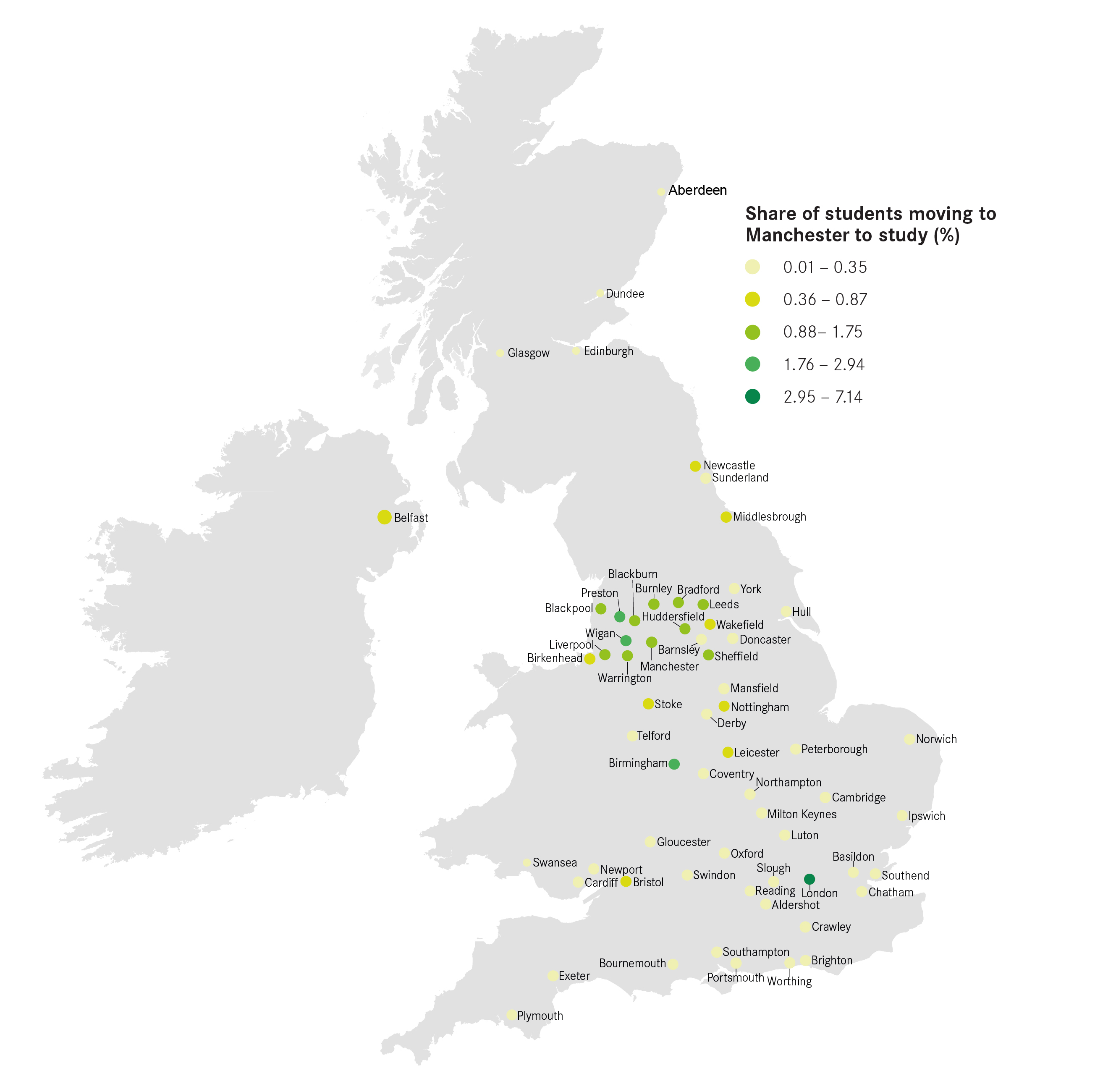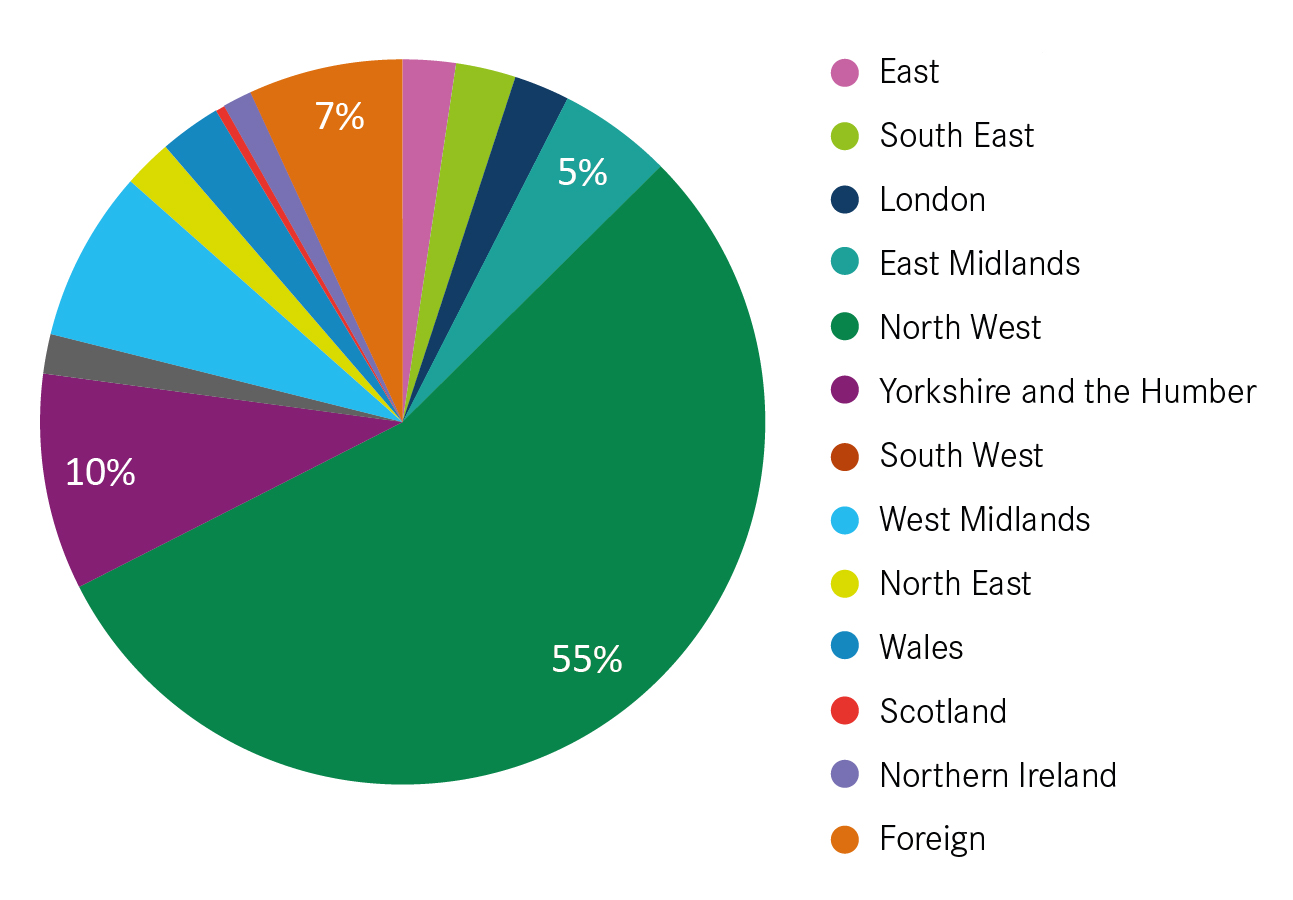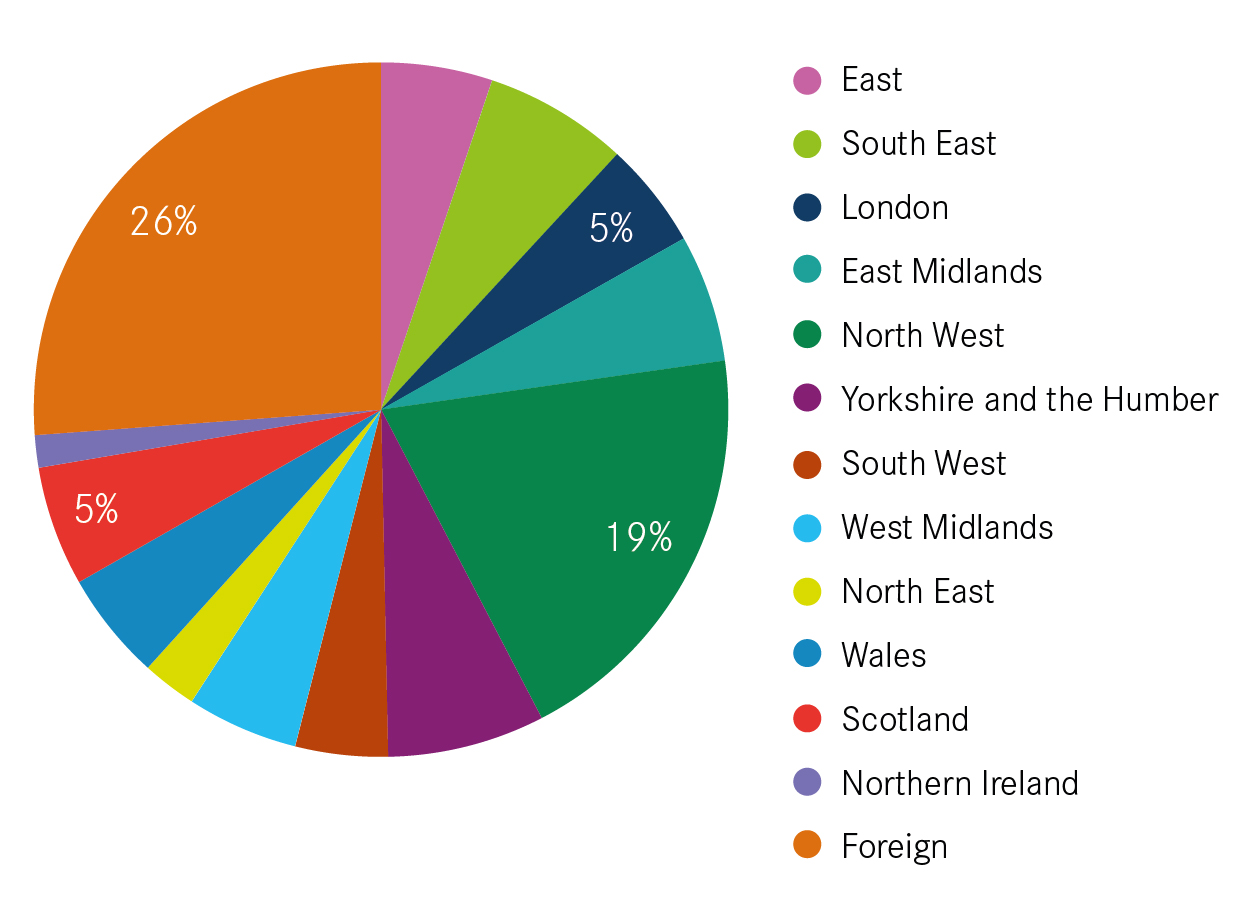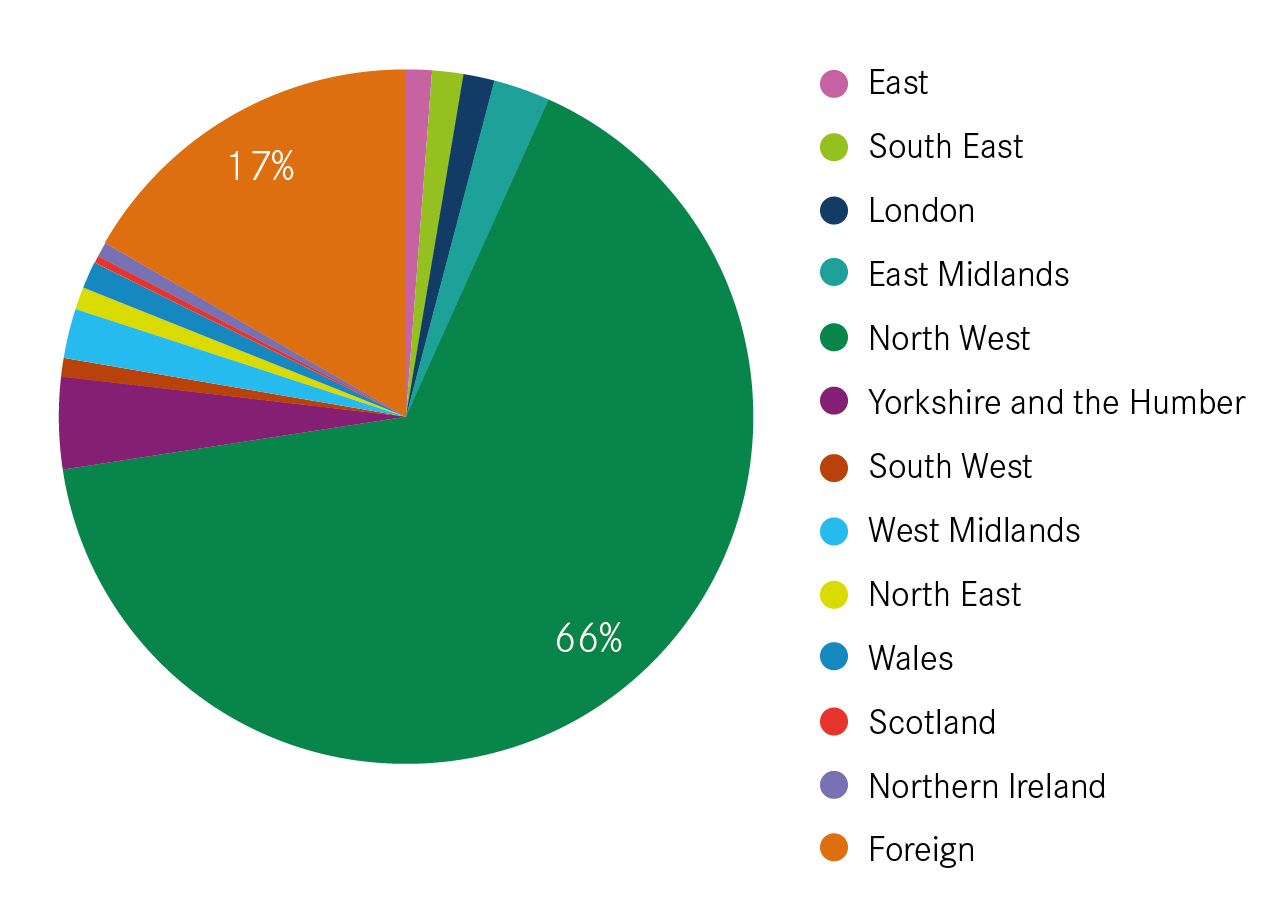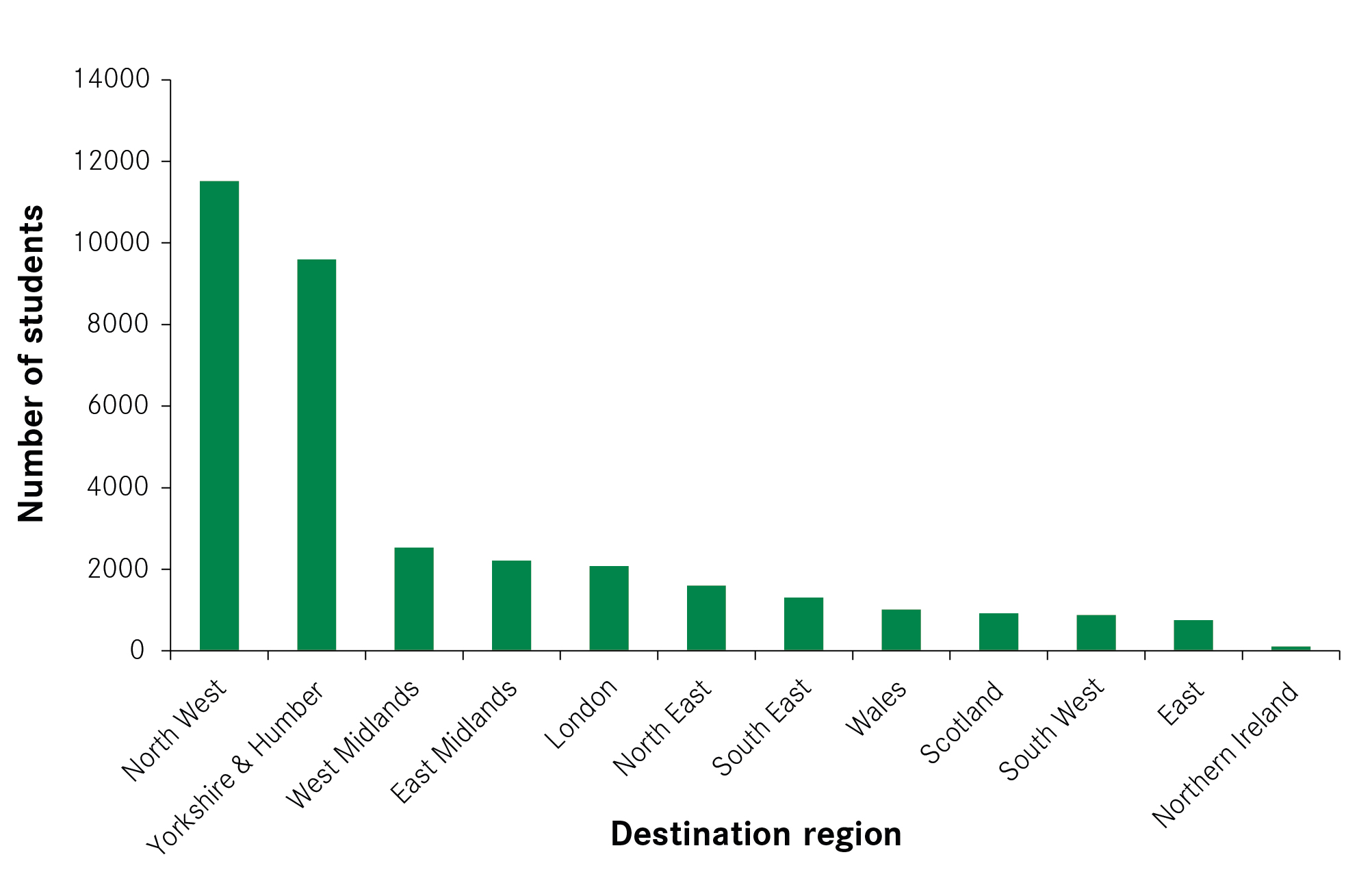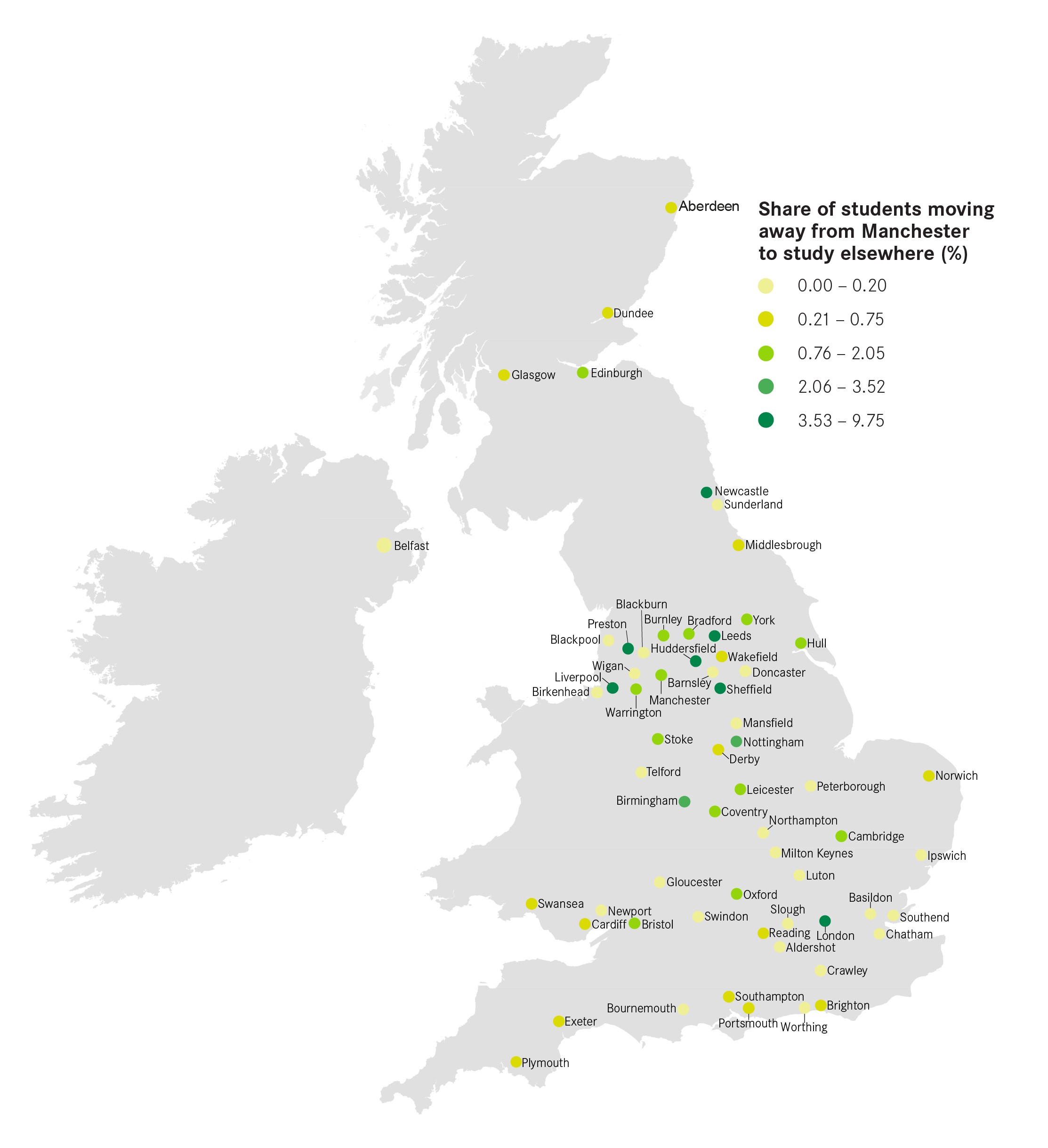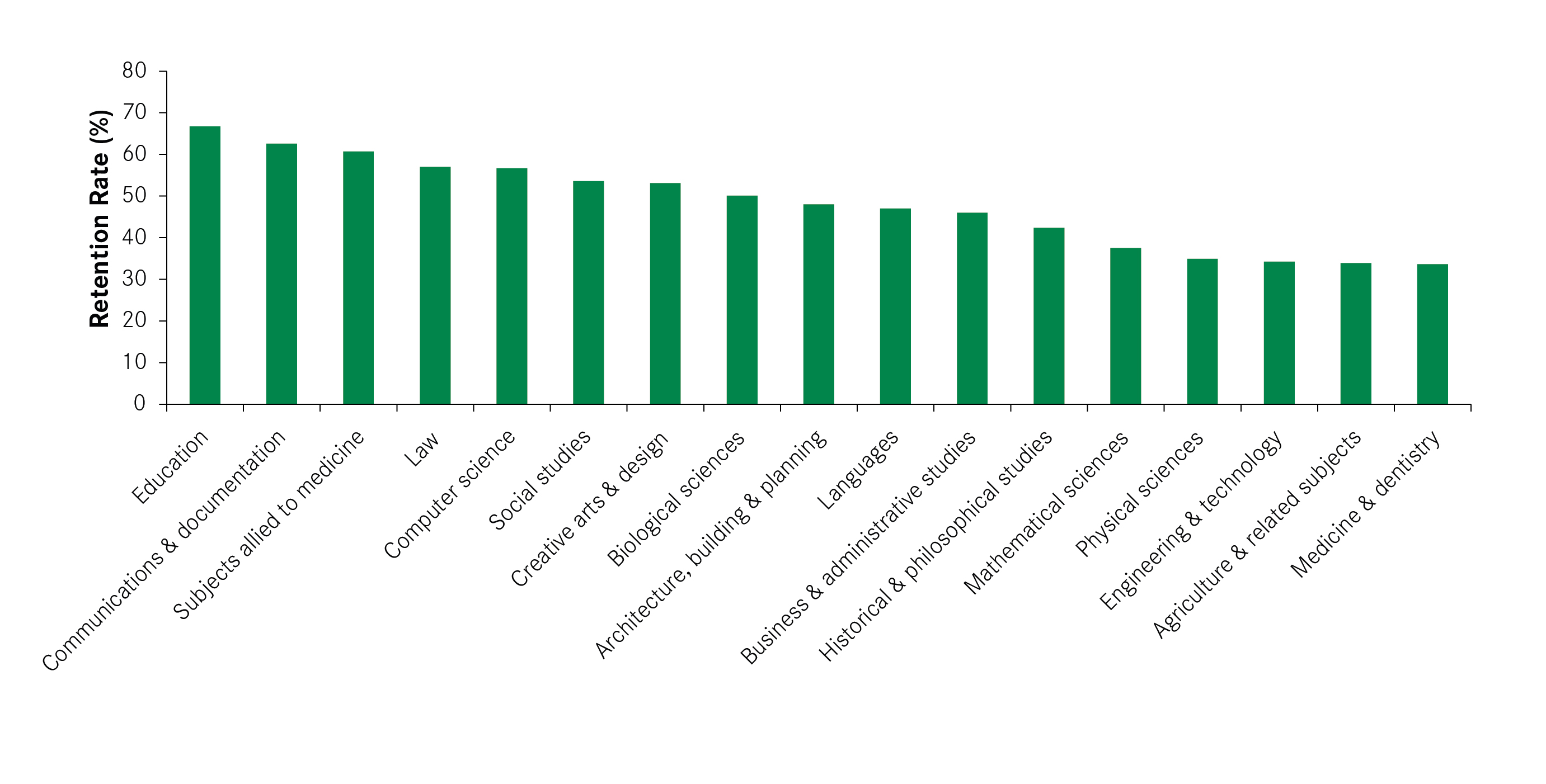03A more detailed look at the movement of students and graduates
The data above suggests that universities play a large role in the movements of people to and from Manchester. This section explores the migration of students and graduates into and out of the city using two data sets from the Higher Education Statistics Authority (HESA). The first looks at admissions (for all students at university in 2014/15), and the second is based on a survey of graduates six months after graduation (for leavers in 2013/14 and 2014/15). Unlike the ONS data used above, it covers the whole of the UK and includes international students.
Box 1: Higher education institutions in Manchester
This analysis covers the five universities with campuses in Manchester: Royal Northern College of Music (RNCM), University of Bolton, Manchester Metropolitan University, University of Salford and the University of Manchester. In the academic year 2014/15 there were 93,060 students enrolled at these universities in Manchester: 1 per cent at RNCM, 7 per cent at the University of Bolton, 30 per cent at Manchester Metropolitan University, 20 per cent at the University of Salford and 42 per cent of the University of Manchester.
Movements of students to university
Almost a third of Manchester’s students were from the city itself
Overall, the student population has a strong local focus, with 31 per cent of students in 2014/15 originally from Manchester and 16 per cent from elsewhere in the North West, as shown in Figure 8. There were also a significant number of international students, accounting for 19 per cent of university students. Of those moving from other regions, Yorkshire and the West Midlands were the most popular origins.
Looking specifically at cities, Figure 9 shows the share of students moving to Manchester from each UK city. London was the most popular city to move from, making up 7 per cent of all students moving to Manchester for university. This was followed by Wigan and Birmingham, where 3 and 2 per cent of students move from respectively.
However, these patterns vary significantly by institution. Both the University of Manchester and RNCM have a diverse student base. A third of the former’s students were from outside the UK, 27 per cent were from the North West and 8 per cent were from London (see Figure 10). At RNCM, 26 per cent of students were international, 19 per cent were from the North West, 5 per cent from Scotland and 7 per cent from the South East (see Figure 12).
In contrast, the University of Salford, Manchester Metropolitan University and the University of Bolton have much more of a local focus. At the University of Bolton, more than three-quarters of students were from the North West. The second largest origin was outside the UK and 5 per cent of students came from Yorkshire (see Figure 14). The University of Salford was similar (see Figure 13), but had a larger share of international students (17 per cent) and a slightly smaller share of regional students (66 per cent).
At Manchester Metropolitan University, half of the student base was from the North West but the other half was a diverse mix of international and domestic students. One in 10 students was from Yorkshire, 8 per cent from the West Midlands, 5 per cent from the East Midlands and 7 per cent were international (see Figure 11).
More than half of Manchester’s students move away from the city for university
Of the 63,620 students originally from Manchester who went to university, 56 per cent studied away from their home city. A third of leavers stayed within the North West and 28 per cent went to university in Yorkshire, equivalent to 11,510 and 9,600 students respectively, as shown in Figure 15. The cities drawing most students from Manchester were Leeds (which attracted 10 per cent of students leaving Manchester), Preston (9 per cent) and Liverpool (8 per cent). As Figure 16 shows, the capital was also a popular destination with 5 per cent of Manchester’s students moving there for university.
Reflecting the movement of young people seen in the previous section, many more students moved into Manchester for university than left to study elsewhere. In 2014/15 the net inflow of students to the city was 10,580; 45,910 students were from outside the city while 35,330 students at other UK universities were originally from Manchester. Despite this significant gain, many more university cities saw larger net inflows. In the same year Leeds gained 32,820 students overall, Nottingham gained 32,020 and Sheffield gained 28,010.
Movements of new graduates post-university
Manchester has a high retention rate compared with other UK cities
Manchester had the second highest retention rate of all university cities in 2013/14 – 2014/15, second only to London (see Figure 17): after graduation, 51 per cent of the city’s university students stayed for work.
However, the retention rate varies significantly depending on which institution the student studied at, as Figure 18 shows. Those who attended the University of Bolton were most likely to stay after graduation, with 68 per cent retained. The University of Salford and Manchester Metropolitan University also had high retention rates, of 61 and 53 per cent respectively. RNCM and the University of Manchester had the lowest shares of students staying in the city for work.
Further nuance can be seen by splitting those who remained in Manchester into two groups: those who grew up, studied and worked in Manchester, and those who came in to study and stayed for work.
This shows that, for the universities with higher retention rates, the majority of students retained were originally from the city. Of those who stayed after studying at the University of Bolton, 83 per cent came from Manchester (see Figure 19) and, for the University of Salford, this figure was 70 per cent. In contrast, the majority of retained students from the University of Manchester and RNCM moved to the city for university.
So the universities with the highest retention rates both had a more locally-focused student base and relied on these home-grown students to achieve the higher levels of retention. This suggests that high retention rates are driven by the regional pull of a university, and by implication explains how the broader national and international pull of the University of Manchester and RNCM contribute to fewer students staying in the city.
Figure 19: Proportion of all retained students from Manchester itself and elsewhere, 2013/14 – 2014/15
Retention rates also vary by subject studied, as Figure 20 shows. In Manchester, two-thirds of those studying Education stayed to work in the city compared with only 34 per cent of Medicine and Dentistry graduates. Other subjects with high retention rates were Law (57 per cent), Computer Science (57 per cent) and Social Studies (54 per cent).
The most popular employment destination for graduates leaving Manchester is London
In 2013/14 – 2014/15, 21 per cent of Manchester graduates who moved away from the city for work chose to locate in London, as shown in Figure 21. The next most popular city destination was Liverpool, but only 4 per cent of graduates moved there for work, highlighting the dominance of the capital in graduate migration patterns. Many graduates stayed close to Manchester, with Wigan, Preston and Warrington each receiving 3 per cent of moving graduates.
Figure 21: Destinations of Manchester graduates who move to other cities for work, 2013/14 – 2014/15
The majority of those who left Manchester to study elsewhere return on graduation
Manchester is very successful at attracting its home-grown students back for work. In 2013/14 – 2014/15, the city has the second highest return rate of all UK cities, only lower than London. Of those who left to study elsewhere, 57 per cent returned to Manchester for work. London saw 74 per cent of leavers come back, Belfast 57 per cent and Birmingham 53 per cent. In contrast, only 28 per cent of leavers returned to Mansfield on graduation and, in Aldershot, the figure was lower at 25 per cent.
Manchester gains graduates overall
Despite the outflow of graduates to other parts of the UK at the end of the university cycle, the number of non-local graduates working in Manchester outweighed the number of local graduates who left to work elsewhere. So, overall Manchester gained graduates.
As Figure 22 shows, there were 5,590 surveyed graduates who grew up in Manchester but left to study or work elsewhere. The city gained 10,250 of those surveyed from other parts of the UK, either when they moved into the city to study (and subsequently stayed for work), or when they moved into the city for the first time after university. This resulted in a gain of 4,660 of the graduates surveyed.
This was the largest gain of any UK city except London, which gained 42,070 graduates. Other cities similar to Manchester were Leeds and Bristol, which gained 3,690 and 3,190 surveyed graduates respectively.
This graduate gain may seem to contradict the earlier finding that there was a net outflow of young graduates from the city (see Figure 6) but this is because there is an additional cohort of students to consider. A significant number of Manchester’s students were ‘bouncers’, who were only temporarily in the city whilst at university. These students moved to Manchester for university but left straight after graduation to work elsewhere, and they are driving the outflow observed in the section above.
Of those who moved to Manchester for university, 67 per cent left became ‘bouncers’ by leaving after graduation. Figure 23 illustrates the size of this group: 9,840 surveyed graduates were ‘bouncers’ (shown by the ark green bar). This was a much larger number of graduates than those gained (shown by the light green bar), and so hides the fact that some students do stay on in the city to work.
Despite this large figure, Manchester has one of the lowest shares of ‘bouncers’ of all UK university cities. Rather than indicating an unattractive graduate job market, this figure instead highlights the national role the city’s universities play in educating graduates for work in many parts of the UK.


